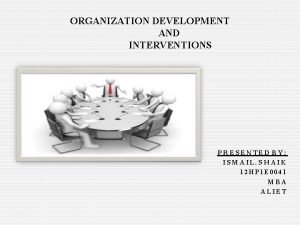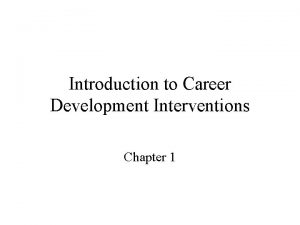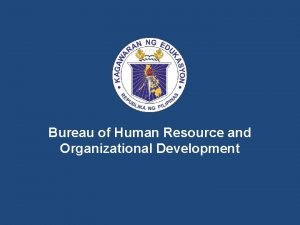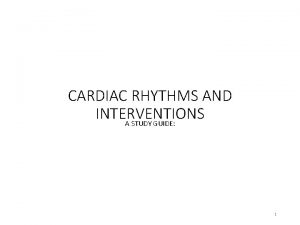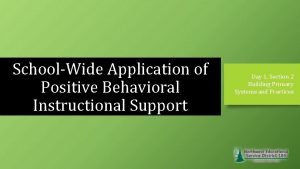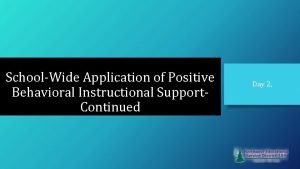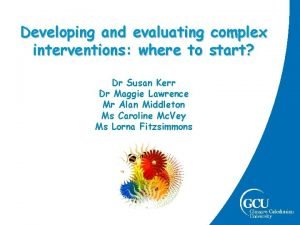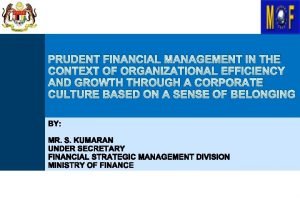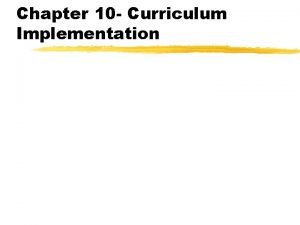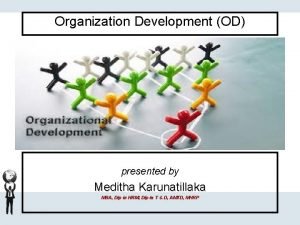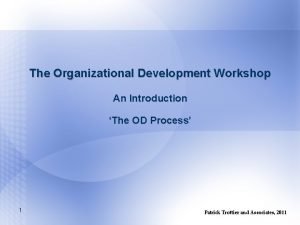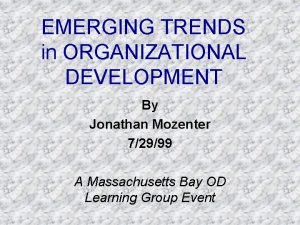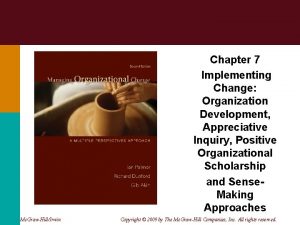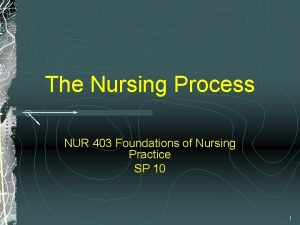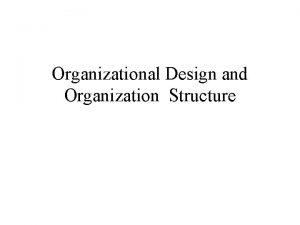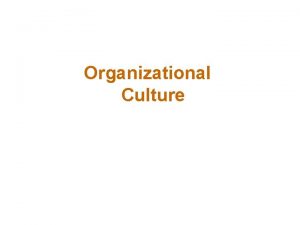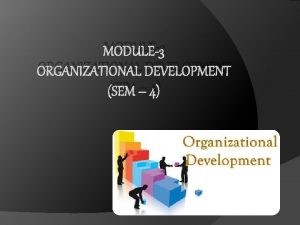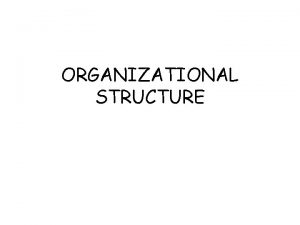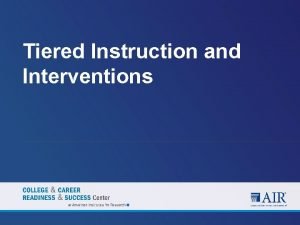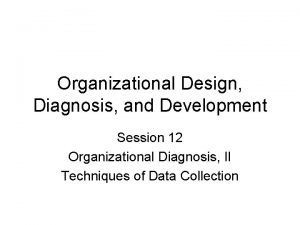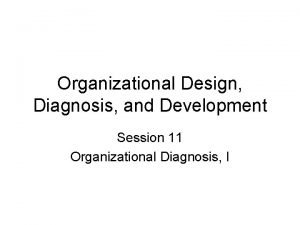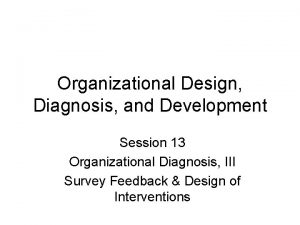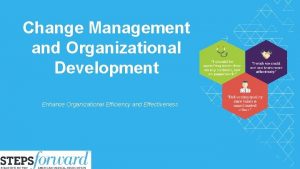ORGANIZATION DEVELOPMENT AND INTERVENTIONS ORGANIZATIONAL DEVELOPMENTOD CONTENTS O



























- Slides: 27

ORGANIZATION DEVELOPMENT AND INTERVENTIONS

ORGANIZATIONAL DEVELOPMENT(OD) CONTENTS: O R G A N I Z AT I O N A L D E V E L O P M E N T. MEANING AND DEFINITIONS OF OD. OBJECTIVES OF OD. A S S U M P T I O N S A N D VA L U E S O F O D. PROCESS OF OD. EFFECTIVENESS OF OD.

INTRODUCTION TO OD: The term organizational development was coined by Richard Beckhard in the mid-1950 s. Organizational development is an acronym of two words i. e. , organization and development. Organization: A social unit of people that is structured and managed to meet a need or to pursue collective goals. Development: The systematic use of scientific and technical knowledge to meet specific objectives or requirements. ORGANIZATION DEVELOPMENT: Organization development (OD) is a deliberately planned effort to increase an organization's relevance and viability. Organizational development is the framework for change, and often times a manager helps to lead this change.

MEANING OF OD: Organization development is known as both a field of applied behavioral science focused on understanding and managing organizational change and as a field of scientific study and inquiry. OD is a systemic learning and development strategy intended to change the basics of beliefs, attitudes, and relevance of values and structure of the current organization to better absorb disruptive technologies, market opportunities, and ensuing challenges and chaos. DEFINITIONS OF OD: According to Middlemist and Hitt define “organizational development is a systematic means for planned change that involves the entire organization and is intended to increase organizational effectiveness. ” Cummings and Huse define OD “A system wide application of behavioral science knowledge to the planned development and reinforcement of organizational strategies, structure, and processes for improving an organization’s effectiveness. ”

Bennis. W define “Organizational development is a response to change, a complex educational strategy intended to change beliefs, attitudes, values, and structures of organizations so that they can better adapt to new technologies, markets, and challenges, and the dizzying rate of change itself. “ Cummings and Worley define “"Organization development is a system- wide application of behavioral science knowledge to the planned development and reinforcement of organizational strategies, structures, and processes for improving an organization's effectiveness. "

OBJECTIVES OF OD: To increase the level of inter-personal trust among employees. To increase employee's level of satisfaction and commitment. To confront problems instead of neglecting them. To effectively manage conflict. To increase cooperation among the employees. To increase the organization problem solving. To put in place process that will help improve the ongoing operation of the organization on a continuous basis.

ASSUMPTIONS AND VALUES OF OD: ASSUMPTIONS VALUES Individuals: �People want to grow and mature. � Employees have much to offer (e. g. � OD creativity and energy) that is not being used at work. �Most employees desire the opportunity to contribute (they desire, seek and appreciate empowerment). aims to overcome obstacles to the natural human tendency to grow, enabling employees to contribute more to the organization. �OD stresses open communication, Treating employees with genuine dignity and respect is emphasized. Groups: � Groups �Hiding and teams are critical to organizational success and individual need satisfaction. �Groups have powerful influences on individual behaviour. � The complex roles to be played in groups require skill development. feelings or not being accepted by the group diminishes individual willingness to solve problems constructively �Acceptance, collaboration and involvement lead to expressions of feelings and perceptions.

Organization: �Excessive controls, policies and rules are detrimental Conflict can be functional if properly channeled Individual and organizational goals can be compatible. � The way groups are linked, influences their Effectiveness, change should start at the top and gradually be introduced through the rest of the organization. �In � The most organizations, the level of interpersonal support, trust and cooperation is lower than desirable and necessary group links the top and bottom of the organization

PROCESS OF OD: Organization Development (OD) is a planned approach to improve employee and organizational effectiveness by conscious interventions in those processes and structures that have an immediate bearing on the human aspect of the organization. A normal OD process can be phased in following manner: . Problem Identification Data Collection Diagnosis Planning and Implementation Evaluation and Feedback

Problem identification: The first step in OD process involves understanding and identification of the existing and potential problems in the organization. The awareness of the problem includes knowledge of the possible organizational problems of growth, human satisfaction, the usage of human resource and organizational effectiveness. Data Collection: Having understood the exact problem in this phase, the relevant data is collected through personal interviews, observations and questionnaires. Diagnosis: OD efforts begin with diagnosis of the current situation. Usually, it is not limited to a single problem. Rather a number of factors like attitudes, assumption, available resources and management practice are taken into account in this phase. There are four steps in organizational diagnosis: � Structural analysis: Determines how the different parts of the organization are functioning in terms of laid down goals.

� Process analysis: Process implies the manner in which events take place in a sequence. It refers to pattern of decision making, communication, group dynamics and conflict management patterns within organization to help in the process of attainment of organizational goals. � Function analysis: performance This includes strategic variables, results, achievements and final outcomes. � Domain analysis: Domain refers to the area of the organization for organizational diagnosis. Planning and implementation: After diagnosing the problem, the next phase of OD, with the OD interventions, involves the planning and implementation part of the change process. Evaluation and feedback: Any OD activity is incomplete without proper feedback. Feedback is a process of relaying evaluations to the client group by means of specific report or interaction

EFFECTIVENESS OF OD: Humanistic values underlie OD. Margulies and Raia articulated the humanistic values of OD as follows: Providing opportunities for people to function as human beings rather than as resources in the productive process. Providing opportunities for each organization member, as well as for the organization itself, to develop to his full potential. Seeking to increase the effectiveness of the organization in terms of all of its goals. Attempting to create an environment in which it is possible to find exciting and challenging work. Providing opportunities for people in organizations to influence the way in which they relate to work, the organization, and the environment. Treating each human being as a person with a complex set of needs, all of which are important in his or her work and life.

ORGANIZATION INTERVENTIONS(OI) CONTENTS INTRODUCTION TO OI. MEANING OF OI. ASSUMPTIONS OF OI. FACTORS THAT HELPS CHANGE AGENT. EXAMPLES OF INTERVENTIONS.

INTRODUCTION TO OI: They may be introduced by a change agent as part of an improvement program, or they may be used by the client following a program to check on the state of the organization's health, or to effect necessary changes in its own behavior. "Structured activities" mean such diverse procedures as experiential exercises, questionnaires, attitude surveys, interviews, relevant group discussions, and even lunchtime meetings between the change agent and a member of the client organization. Every action that influences an organization's improvement program in a change agent-client system relationship can be said to be an intervention. There are many possible intervention strategies from which to choose.

MEANING OF OI: "Interventions" are principal learning processes in the "action" stage of organization development. Interventions are structured activities used individually or in combination by the members of a client system to improve their social or task performance. Interventions range from those designed to improve the effectiveness of individuals through those designed to deal with teams and groups, intergroup relations, and the total organization. There are interventions that focus on task issues (what people do), and those that focus on process issues (how people go about doing it). Finally, interventions may be roughly classified according to which change mechanism they tend to emphasize: for example, feedback, awareness of changing cultural norms, interaction and communication, conflict, and education through either new knowledge or skill practice.

EXAMPLES OF INTERVENTIONS: A few examples of interventions include Team Building. Coaching. Large Group Interventions. Mentoring. Sensitivity training Survey feedback TQM And Leadership Development.

Definition of sensitivity training Sensitivity Training is a form of training that claims to make people more aware of their own prejudices, and more sensitive to others. According to its critics, it involves the use of psychological techniques with groups that its critics.

Definition of team building 1. High interaction among team members to increase trust and openness. 2. Team building uses high interaction group activities to increase trust & openness among team members, improve coordinative efforts, and increase team performance.

Process of team building Problem sensing Examining deferences Giving & receiving feedback Developing interactive skills Follow-up actions

Survey feedback The use of questionnaires to identify discrepancies among members perceptions, discussion follows, & remedies are suggested.

Process of Survey feedback Data collection Feedback & information Follow-up action

Process Consultation The basic content of p-c is that the consultant works with individuals and groups in the organisation to help them learn about human and social processes and to solve problems that stem from process events.

Process Consultation Initiate contact Define the relationship Select the setting and the method Gather data & make a diagnosis Intervene Reduce involvement & terminate

FACTORS THAT HELP CHANGE AGENT: Some of the things which will help him are: A real need in the client system to change. Genuine support from management. Setting a personal example: listening, supporting behavior. A sound background in the behavioral sciences. A working knowledge of systems theory. A belief in man as a rational, self-educating being fully capable of learning better ways to do things.

References: �www. wikipedia. com �www. businessdictionary. com � www. boundless. com � www. msu. edu. com

Questions ?

Thank you
 Organizational development interventions examples
Organizational development interventions examples Misconceptions about career assessment
Misconceptions about career assessment Point by point organization example
Point by point organization example Deped human resource development plan
Deped human resource development plan Process organization in computer organization
Process organization in computer organization Jones and bartlett 2012 ekg strips
Jones and bartlett 2012 ekg strips Positive behavioral interventions and supports
Positive behavioral interventions and supports Positive behavioral interventions and supports
Positive behavioral interventions and supports Developing and evaluating complex interventions
Developing and evaluating complex interventions Dementia treatments and interventions near patterson
Dementia treatments and interventions near patterson Prudent financial management
Prudent financial management Types of od intervention
Types of od intervention Development change adalah
Development change adalah Organizational development model in curriculum
Organizational development model in curriculum Mba project on organizational development
Mba project on organizational development Organizational development workshop
Organizational development workshop Organizational development trends
Organizational development trends Organizational development proposal presentation
Organizational development proposal presentation Positive organizational development
Positive organizational development Content of a dead man's pocket
Content of a dead man's pocket Superior mediastinum
Superior mediastinum Outlining and organizing the speech contents
Outlining and organizing the speech contents Contents of the dead man's pocket questions and answers
Contents of the dead man's pocket questions and answers Soft words safewards
Soft words safewards Planning is a category of nursing behaviors in which
Planning is a category of nursing behaviors in which Actual nursing diagnosis
Actual nursing diagnosis Collaborative interventions nursing
Collaborative interventions nursing Nursing care plan example
Nursing care plan example
